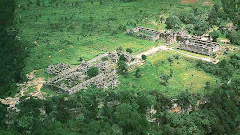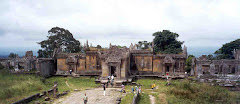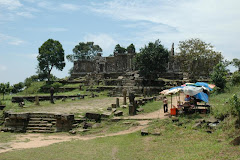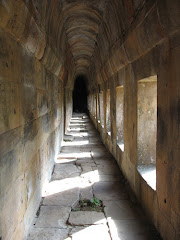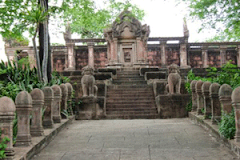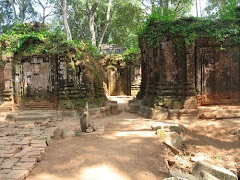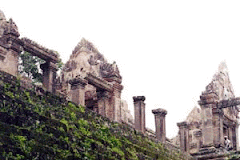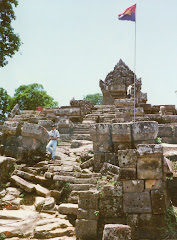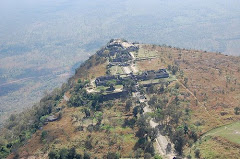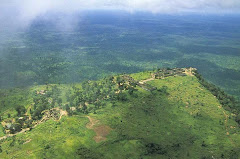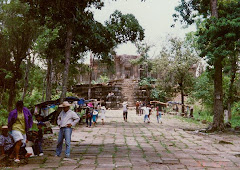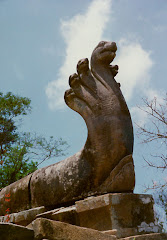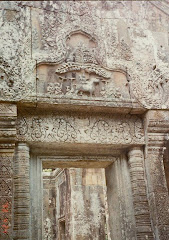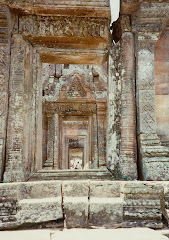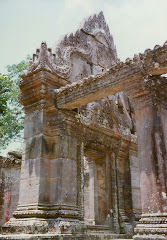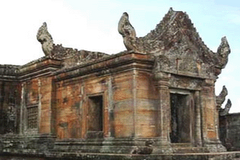HISTORY OF CAMBODIA
Before A.D.100 (Pre-FUNAN Times)
Before A.D.100 (Pre-FUNAN Times)
At the end of the ice age (12,000BC) the Indo-Chinese region is firstly inhabited by Australoid peoples. The land bridges between Malaya, the Indonesian islands and Australia are submerged. Various population groups migrate through southeast Asia. The Mon-Khmer people gradually settle in the lands which later become the kingdoms of Funan and Chenla and they become the dominant tribes in the area.
GEOGRAPHY OF INDO-CHINA
 The Indo-Chinese region today comprises the countries of Laos, Cambodia, Vietnam and Thailand. It is made up of large fertile plains which lie around two rivers, the Mekong and the Tonle Sap.
The Indo-Chinese region today comprises the countries of Laos, Cambodia, Vietnam and Thailand. It is made up of large fertile plains which lie around two rivers, the Mekong and the Tonle Sap.
[Map] The land is settled by various tribes who develop the independent kingdoms of Tonkin, Annam, Cochin China, Cambodia, Laos and Siam.
B.C.4000-A.D.100 Settlements are formed throughout the Indo-China region. The major cultural influences on the region are from China and India. The Dong-Son culture becomes established in the northern part of today's Vietnam.
A.D.100-A.D.600 THE KINGDOM OF FUNAN
 [Map] A.D.100 The Kingdom of Funan, part of the lands which will become the vast Khmer Empire or Cambodia, is established by the legendary Indian brahmin, Kambu. The peaceful settlement of Indian traders begins the process of Indianization of Cambodia.
[Map] A.D.100 The Kingdom of Funan, part of the lands which will become the vast Khmer Empire or Cambodia, is established by the legendary Indian brahmin, Kambu. The peaceful settlement of Indian traders begins the process of Indianization of Cambodia. A.D.245 Two Chinese ambassadors visit Funan and produce a report on all aspects of life in the kingdom. AD357 King Chandan, who is probably of Indian origin, comes to the throne of Funan. He is succeeded by another brahmin ruler.
A.D.245 Two Chinese ambassadors visit Funan and produce a report on all aspects of life in the kingdom. AD357 King Chandan, who is probably of Indian origin, comes to the throne of Funan. He is succeeded by another brahmin ruler.
End AD400-AD500 The Kingdom of Funan is a prosperous trading region, lying on the trade and pilgrimage route between India and China.

Indian culture still plays an important part in the developing Kingdom of Funan, although native influence over customs, art, architecture and religion is now also very strong. Both forms of Hinduism and Mahayana Buddhism, a type of Buddhist religion popular in India and China, exist in Funan. At that time (AD400-AD514)the king of China had given the king's name of Funan " The Southeast General Of Peace is Funan's King".
6th century There is evidence from the texts of contemporary Chinese historians that the Funan Empire is strong and respected throughout Asia. Indian influence is still very much evident in all areas of life. Trade in Funan is centered in the prosperous port city of Oc-eo.
A.D.514-AD539: King Rudravarman is the last of the great kings of Funan. He cultivates the worship of the Hindu god Vishnu. Statues of the god dating from his reign still exist today, showing the influence of contemporary Indian art and religious iconography.
A.D.550 Prince Bhavavarman of the Funan royal family (and grandson of King Rudravarman) marries the female heir to the throne of Chenla, a fertile kingdom to the north of Funan occupying the territory which today is Laos. Chenla is inhabited by the Mon-Khmer people whose leaders are related to the Funan royal family before the time of Bhavavarman.On the Chenla king's death, Bhavavarman becomes King of Chenla, and when the Funan king dies, he siezes Funan as well. Within a few years, Funan becomes a vassal state to Chenla.
A.D.600-A.D.800 THE KINGDOM OF CHENLA
A.D.600-A.D.611: Bhavavarman is succeeded by Mahendravarman and then by Isanavarman, both of whom are strong kings and complete the process of integrating Funan into Chenla.The capital of Chenla is initially at Sambor, some 40 miles southeast of Angkor.
 A.D.616-A.D.635: King Isanavarman rules the Kingdom of Chenla with his capital at Sambor Prei Kuk. Architecture develops in the kingdom using sandstone for building and beautiful carvings in stone for the temples.
A.D.616-A.D.635: King Isanavarman rules the Kingdom of Chenla with his capital at Sambor Prei Kuk. Architecture develops in the kingdom using sandstone for building and beautiful carvings in stone for the temples.
A.D.635-A.D.656: King Bhavavarman II rules Chenla. Mahayana Buddhism spreads in Chenla. Statues celebrating this religion are found.
In A.D.750, Jayavarman I becomes King of Chenla. His reputation is as a strong war-like king who expands the Chenla kingdom through his many conquests. Ruined temples from this time still stand in the land around the Angkor region. Wars of succession divide and weaken Kambuja. Contact with India is broken and trade ceases. As the Kingdom of Chenla declines, the Saliendra dynasty in Indonesia rises to power. It is possible that this Indonesian dynasty may have, in part, descended from the royal family of Funan.
In A.D.800, This is a period of weakness and eventual disintegration into individual states for the Kingdom of Chenla. There is an administrative breakdown which results in the separate states being powerless. Meanwhile the Saliendra dynasty, the ruling house of the Indonesian Empire, becomes increasingly powerful and starts expanding in southeast Asia. The Saliendra king of Java invades Chenla and claims the throne, possibly on the grounds that he is descended from the royal house of Funan. Cambodia becomes a vassal state of Java.
THE KINGDOM OF KAMBUJA
A.D.800-A.D.850: Jayavarman II, a young man connected to the Chenla royal family and educated at the Saliendra court in Java, returns to Chenla in AD790. He becomes king around AD800. Initially he extends his kingdom by seizing land to the north and east of Chenla. His 50-year reign is decisive in developing the Khmer Kingdom by establishing its constitution, religion and capital. His reign also sees important changes in Khmer architecture. He builds several capitals, but finally establishes his principal capital at Roluos, about 10 miles southeast of today's town of Siem Reap. He names this city Hariharalaya.
A.D.850-A.D.877: Jayavarman III, son of Jayavarman II, succeeds the throne of Kambuja and continues to rule the empire from the city at Roluos.
A.D.877-A.D.889: Indravarman I, a nephew of Jayavarman II, rules Kambuja. He is learned and brings peace and unity to the Khmer Kingdom. He has a wide reputation for being a strong king throughout southeast Asia. His peaceful reign and the income from the expanding Khmer Empire enables King Indravarman I to embark on an ambitious building program.
In A.D.877, Indravarman builds a large reservoir north of the city.
A.D.889-A.D.900: Yasovarman I (son of Indravarman) is King of Kambuja. He supposedly descends from the Funan royal family through his mother. Many inscriptions found on temple walls describing the events of his rule date from his reign. It is believed that he was a strong but tyrannical ruler. He moves the city from Roluos to the present site of Angkor, a few miles from today's town of Siem Reap. Here he [Map] builds the city of Yasodharapura with the Bakheng as the central temple. At Roluos he builds the Lolei Temple in the center of the baray.
A.D.900-A.D.921: Harshavarman I, Yasovarman's brother, rules. He builds his temple-mountain, the Baksei Chamkrong, a stone pyramid with a single tower.
In A.D.921, Harshavarman's uncle, Jayavarman IV,divides the kingdom and sets up a rival capital about 60 miles to the north east of Angkor in the old Chen La Kingdom at Koh Ker. His son rules in this new capital.Prasat Kravan is built to honor Lakshmi, the wife of Vishnu. It is a brick temple with a rich beautiful shrine. This is one of the first temples not to be dedicated by a king, but rather by an individual or member of the hereditary aristocracy.
A.D.930-A.D.944: An usurper successor (whose name is unknown) rules, followed by his son. The capital remains far away from the Angkor site.
A.D.944-A.D.968: Rajendravarman II, a descendant of Yasovarman I, rules Kambuja and brings the court back to the old capital, Yasodharapura, at Angkor. He continues to expand the Khmer Empire further and manages an impressive building program during his relatively short reign. The Sanskrit inscriptions on the temples remaining from this reign tell us that this king was wise and tolerant. Several Mahayana Buddhist establishments are set up at Angkor during his reign.
In A.D.950, Rajendravarman II attacks the Cham Kingdom which lies to the east of Kambuja.
In A.D.950, Rajendravarman II attacks the Cham Kingdom which lies to the east of Kambuja.
A.D.968-A.D.1001: Jayavarman V rules Kambuja. His reign is marked by peace, prosperity and cultural development. Jayavarman V's court is filled with scholars, poets, ministers, ecclesiastics and philosophers who discuss the mysteries of the world, paint its beauties, write music and songs, dance for the delight of the king and his courtiers and build wonderful temples, among them the exquisite temple of Banteai Srei. Jayavarman V also builds the temple of Ta Keo which is dedicated to Siva and is the first of the Angkor temples to be built completely of sandstone.
A.D.980-A.D.1220 THE DEVELOPMENT OF THE CITY OF ANGKOR

A.D.1001-A.D.1002: King Udayadityavarman I rules, followed by Jayaviravarman I, both descendants of the royal house of Kambuja.
The king Udayadityavarman I mounted the throne in A.D.1000-1002. He was a nephew of Jayavarman V. When Jayavaraman V died in the year 1001, one of his relatives named Udayadityavarman took the throne. A few months later he disappeared, no one known whether he had abdicated or died. After that there was a civil war; the country at that point had been divided into many parts by many kings. Each king believed that the country belonged to them. He married the local princess and become king of Bali under the name Udayana
A.D.1002 – A.D.1010: King Jayaviravarman I mounted the throne in A.D.1002-1010. Not much is known about Jayaviravarman; he is said to rule concurrently over different portions of Cambodia from A.D.1002 until Suryavarman I conquers the whole country and ruled exclusively in A.D.1010.
A.D.1010-A.D.1050: Suryavarman I (Narvanapalala) was king of the Khmer Empire from A.D.1010 to A.D.1050. After the reign of Udayadityavarman I, which ended around 1000, there was no clear successor. Two kings, Jayaviravarman and Suryavarman I, both claimed the throne. Suryavarman I was a Buddhist who was said in the Chronicles of Chieng Mai to be of Malaysian origin. After nine years of war, Suryavarman I won the throne. His reign lasted some 40 years and he spent much of that time defending it. Known as the "King of the Just Laws," he consolidated his political power by inviting some four thousand local officials to the royal palace and swear an oath of allegiance to him. Suryavarman I made Buddhism the state religion. However, he allowed the people to continue practising Hinduism if they wished.
The king Udayadityavarman I mounted the throne in A.D.1000-1002. He was a nephew of Jayavarman V. When Jayavaraman V died in the year 1001, one of his relatives named Udayadityavarman took the throne. A few months later he disappeared, no one known whether he had abdicated or died. After that there was a civil war; the country at that point had been divided into many parts by many kings. Each king believed that the country belonged to them. He married the local princess and become king of Bali under the name Udayana
A.D.1002 – A.D.1010: King Jayaviravarman I mounted the throne in A.D.1002-1010. Not much is known about Jayaviravarman; he is said to rule concurrently over different portions of Cambodia from A.D.1002 until Suryavarman I conquers the whole country and ruled exclusively in A.D.1010.
A.D.1010-A.D.1050: Suryavarman I (Narvanapalala) was king of the Khmer Empire from A.D.1010 to A.D.1050. After the reign of Udayadityavarman I, which ended around 1000, there was no clear successor. Two kings, Jayaviravarman and Suryavarman I, both claimed the throne. Suryavarman I was a Buddhist who was said in the Chronicles of Chieng Mai to be of Malaysian origin. After nine years of war, Suryavarman I won the throne. His reign lasted some 40 years and he spent much of that time defending it. Known as the "King of the Just Laws," he consolidated his political power by inviting some four thousand local officials to the royal palace and swear an oath of allegiance to him. Suryavarman I made Buddhism the state religion. However, he allowed the people to continue practising Hinduism if they wished.
His palace was situated in the vicinity of Angkor Thom, and he was the first of the Khmers rulers to protect his palace with a wall. In 1022 Suryavarman I expanded his territory to the west to Lopburi in Thailand and into Laos.
The major constructions built by this king were the Prasat Preah Vihear on Dangrek Mountain, and Prasat Phimeanakas. Suryavarman I also started the second Angkor reservoir, the West Baray, which is five miles (eight kilometers) long and one mile (1.6 kilometers) wide. It held more than 150 million gallons (567 million liters) of water. This is the largest Khmer reservoir that survives.
The king Suryavarman I died in 1050. He was succeeded by his sons, Udayadityavarman II, who died around 1066 and Hashavarman III (Sadasivapada). The latter continued the struggle against internal rebellions and fought back assaults from the Chams until his death in 1080.

A.D.1050–A.D.1066: King Udayadityavarman II ruled over the Angkor Kingdom from 1050-1066. He was not the son of Suryavarman I, but a descendant from the different lineage of Yasovarman I's spouse. The stone inscription during his reign praised one of his faithful general Sangrama who quell several major rebellions for the king. Udayadityavarman II built the renowned Baphoun Temple devoted to god Shiva, however, it appeared that some stone sculptures were also dedicated to Lord Buddha. This king completed the construction of the West Baray started since the time of his former king, and built the West Mebon, a raise-earthen island, in the center of it. A temple dedicated to god Vishnu was constructed on the island, but now had long been vanished. The West Baray is still in use today. During his reign, several attempted rebellions were crushed by his general Sangrama.
The Sdok Kak Thom temple, located near the present day Thai town of Aranyaprathet, was also constructed during his reign. The temple is perhaps most famous as the discovery site of a detailed inscription recounting the sequence of previous Khmer kings. The inscription stele is now part of the collection of the national museum in Bangkok.
A.D.1066-A.D.1080: King Harshavarman III mounted the throne in 1066-1080 after the death of Udayadityavarman II . The new king Harshavarman III who was the former king's older brother.
A.D.1080-A.D.1107: King Jayavarman VI, Ascending the throne in 1080, did not seem to have any direct connection with the royal family of the preceding kings. Probably he was from the different maternal sub-lineage, which was too far to entitle his right to the crown. The center of his ancestors' power was more or less to the West of the Angkor in the area of Phimai, now in Thailand. Jayavarman VI claimed to be the descendents of legendary Kambu and Mera, which was different from his immediate predecessors. This could imply that he succeeded the throne through violent conflict. During his reign, there was rarely any monument built, except the one at the center of his power - the Phimai temple.
A.D.1107-A.D.1113: Jayavarman VI's brothers rule. Rival claims to the throne and civil war continue and the kingdom is temporarily partitioned. Suryavarman, an ambitious nobleman who claimes he is related to the Cambodian royal family, takes advantage of the weakened kingdom and seizes power. He deposes both kings and takes the throne.
A.D.1080-A.D.1107: King Jayavarman VI, Ascending the throne in 1080, did not seem to have any direct connection with the royal family of the preceding kings. Probably he was from the different maternal sub-lineage, which was too far to entitle his right to the crown. The center of his ancestors' power was more or less to the West of the Angkor in the area of Phimai, now in Thailand. Jayavarman VI claimed to be the descendents of legendary Kambu and Mera, which was different from his immediate predecessors. This could imply that he succeeded the throne through violent conflict. During his reign, there was rarely any monument built, except the one at the center of his power - the Phimai temple.
A.D.1107-A.D.1113: Jayavarman VI's brothers rule. Rival claims to the throne and civil war continue and the kingdom is temporarily partitioned. Suryavarman, an ambitious nobleman who claimes he is related to the Cambodian royal family, takes advantage of the weakened kingdom and seizes power. He deposes both kings and takes the throne.
A.D.1113-A.D1150: Suryavarman II rules Kambuja. Initially, he concentrates on territorial expansion and conquers [Map]the neighboring kingdom of the Chams, extending the limits of the Khmer Empire more than ever before. He embarks on an ambitious building program, expanding the city of Angkor and building many temples including Preah Pithu, Chansay Tevoda and Thommanon, all in the Angkor region. Angkor Wat, a temple dedicated to the god Vishnu, and generally recognized as the highest achievement of Khmer temple architecture, is also built during his reign.

In A.D.1145, Suryavarman plans to seize control of all of Annam and asks the king of Champa to assist him. He refuses so Suryavarman deposes him and annexes his kingdom. The Cham regain independence in A.D.1149.
In A.D.1150, Suryavarman II tries to reconquer Annam. He leads his armies through jungle mountains where they die of fever. He dies in 1150, leaving the kingdom exhausted and weak. The last inscription, which mentions his name in connection with a planned invasion of Vietnam, is from the year 1145. He probably died during a military expedition between A.D.1145 and A.D.1150.
A.D.1150-A.D.1160: King Dharanindravarman II (Paramanishkalapada) was king of the Khmer Empire from 1150 to 1160. His son Jayavarman VII would become known as one of the most ambitious builders of Angkor, the empire's capital.
A.D.1160 -A.D.1165: King Yasovarman II was the ruler of the Khmer empire from 1160 to 11665. He succeeded Suryavarman II. His rule ended with his assassination by one of his subordinates.
A.D.1165-A.D.1177: King Tribhuvana-dityavarman Killed at the battle against the Cham.
A.D.1150-A.D.1160: King Dharanindravarman II (Paramanishkalapada) was king of the Khmer Empire from 1150 to 1160. His son Jayavarman VII would become known as one of the most ambitious builders of Angkor, the empire's capital.
A.D.1160 -A.D.1165: King Yasovarman II was the ruler of the Khmer empire from 1160 to 11665. He succeeded Suryavarman II. His rule ended with his assassination by one of his subordinates.
A.D.1165-A.D.1177: King Tribhuvana-dityavarman Killed at the battle against the Cham.
A.D.1181-A.D.1215: King Jayavarman VII was a king of the Khmer Empire in present day Siem Reap. Cambodia. He was the son of King Dharanindravarman II (1150-1160) and Queen Sri Jayarajacudamani. He married Jayarajadevi and then, after her death, married her sister Indradevi. The two women are commonly thought to have been a great inspiration to him, particularly in his unusual devotion to Buddhism. Only one previous Khmer king had been a Buddhist.
Jayavarman VII probably spent his early years away from the Khmer capital. He may have spent time among the Cham of modern-day Vietnam. The Cham shared with the Khmer the Hindu and Buddhist religions, as well as the use of Sanskrit as a formal language.
In A.D.1177 and again in 1178, the Cham invaded Cambodia. In 1178, they launched a surprise attack on the Khmer capital by sailing a fleet up the Mekong River, across Lake Tonle Sap, and then up the Siem Reap River, a tributary of the Tonle Sap. The invaders pillaged the Khmer capital of Yasodharapura and put the king to death, as well as taking the Apsara dancers, the route of Thai classical dancing. Also in 1178, Jayavarman came into historical prominence by leading a Khmer army that ousted the invaders. At the time, he may already have been in his 60s. Returning to the capital, he found it in disorder. He put an end to the disputes between warring factions and in 1181 was crowned king himself. Early in his reign, he probably repelled another Cham attack, quelled a rebellion, and rebuilt the capital of Angkor. In 1191, he sacked the capital of Champa.
Over the 30 some years of his reign, Jayavarman embarked on a grand program of construction that included both public works and monuments. As a Mahayana Buddhist, his declared aim was to alleviate the suffering of his people. One inscription tells us, "He suffered from the illnesses of his subjects more than from his own; the pain that affected men's bodies was for him a spiritual pain, and thus more piercing." This declaration must be read in light of the undeniable fact that the numerous monuments erected by must have required the labor of thousands of workers, and that Jayavarman's reign was marked by the centralization of the state and the herding of people into ever greater population centers.
Historians have identified three stages in Jayavarman's building program. In the first stage, he focussed on useful constructions, such as hospitals, rest houses along the roads, and reservoirs. Thereafter, he built a pair of temples in honor of his parents: Ta Prohm in honor of his mother and Preah Khan in honor of his father. Finally, he constructed his own "temple-mountain" at Bayon and developed the city of Angkor Thom around it. He also built Neak Pean ("Coiled Serpent"), one of the smallest but most beautiful temples in the Angkor complex, a fountain with four surrounding ponds set on an island in that artificial lake.
In A.D.1186, the king Jayavarman VII dedicated Ta Prohm ("Ancestor Brahma") to his mother. An inscription indicates that this massive temple at one time had 80,000 people assigned to its upkeep, including 18 high priests and 615 female dancers. The first Lara Croft film was shot in Ta Prohm as well as a few scenes from the movie Troy.
The king Jayavarman VII also built the temple and administrative complex of Preah Khan ("Sacred Sword"), dedicating it to his father in 1191.
Angkor Thom ("Big Angkor") was a new city centre, called in its day Indrapattha. At the centre of the new city stands one of his most massive achievements, the temple now called the Bayon, a multi-faceted, multi-towered temple that mixes Buddhist and Hindu iconography. Its outer walls have startling bas reliefs not only of warfare but the everyday life of the Khmer army and its followers. These reliefs show camp followers on the move with animals and oxcarts, hunters, women cooking, female traders selling to Chinese merchants, and celebrations of common foot soldiers. The reliefs also depict a naval battle on the great lake, the Tonle Sap. The historical record is a mixture of the incredibly precise (we know the exact date that a temple was consecrated) and more ambiguous texts and archaeological evidence. Thus, many of the dates marking the life and reign of Jayavarman VII are a matter of conjecture and inference. What is known is that King Suryavarman (Sun Shield) II, builder of the great Angkor Wat, died some time in the early 1150s. He was succeeded by Yashovarman II who was himself overthrown by Tribhuvanadityavarman (Protegee of the Three Suns) assumed to be an usurper. There is a minority view that the current biography of Jayavarman is imaginary and that the evidence could just as easily support the view that he was the usurper. One date that has been generally accepted is 1177 when the Chams, who had themselves been subjected to numerous Khmer invasions, took the city of Yashodharapura. Nonetheless, this date, not to mention the event itself, has been questioned by Michael Vickery, who doubts the reliability of the Chinese sources for this period. A Cham king took the title of Jaya-Indravarman. In 1181 Jayavarman VII became King after leading the Khmer forces against the Chams.
The king Jayavarman VII died in about 1215, at an advanced age ranging from 85 to 90. He was succeeded by Indravarman about whom almost nothing was written. There is only one inscription about him, one that establishes he had died by 1243. This lack of praise and pomp led David P. Chandler, in an influential article, to speculate that Indravarman may have been the Leper King of Cambodian legend and later record. Indravarman was succeeded by Jayavarman VIII who it is thought supported a Hindu revolt. Certainly there is evidence of enormous and organised defacing of Jayavarman VII's works. The niches all along the top of the wall around the city contained images of the Buddha. Most of these were removed. A statue of Jayavarman VII was found by excavators having been thrown down a well. Buddha images in Preah Khan were re-worked to resemble Brahmins. When Cambodia finally did become a Buddhist country, it followed Theravada Buddhism, not the Mahayana Buddhism practised by Jayavarman VII.

In A.D.1296, The Chinese ambassador and his entourage visit Kambuja and spend a year in Angkor. Chou Ta-Kuan, one of the Chinese officials, writes his report of late 13th century Kambuja from which much of our knowledge of the kingdom at this time is drawn.
In A.D.1350, The Thai capital is moved to Ayudhya, near Angkor. This threatens the increasingly weak Cambodian Kingdom.
A.D.1350-A.D.1430: Almost continual warfare between the Thais and Khmers is waged during this period.
In A.D.1369, The Thais attack Angkor and take the city. They control it briefly.
In A.D.1389, Angkor again falls to the Thais.
In A.D.1431, The Thais launch a major attack on Angkor. After a seven-month siege, Angkor falls and is sacked and looted. The city is deserted the following year and the capital is moved east to the region of Phnom Penh.
THE PERIOD OF VASSALAGE TO THAILAND AND VIETNAM
A.D.1450-A.D.1860: From the mid-15th century onwards, after Angkor falls to the Thais, the Khmer Empire is in serious decline. The Vietnamese and Thai Empires control the Indo-China peninsula. Warfare continues between the Thais and Khmers, with Kambuja periodically becoming little more than a vassal state of Thailand.
A.D.1516-A.D.1566: King Ang Chan rules Kambuja. His reign sees a strengthening of the Khmer Kingdom and some raids into Thailand are made.
In A.D.1564, The Khmers reach Ayudhya, the capital of Thailand, try to annex it, but find it already occupied by the Burmese.
A.D.1566-A.D.1576: King Barom Reachea I rules Kambuja. There is a second period of greater Khmer strength and some temporary success in the wars against the Thais. The Cambodian court briefly reoccupies Angkor.
THE SANISH INTERLUDE
A.D.1576-1594: Under constant attack from the Thais, King Satha, who rules Kambuja, seeks military support from the Spanish, who by this time are well established in southeast Asia.
In A.D.1594, The Thais capture the new Cambodian capital at Lovek.
In A.D.1594, Satha is deposed. The usurper, Chung Prei, becomes king.
In A.D.1596, A Spanish expedition arrives in Cambodia to aid King Satha against the Thais. They sack the Chinese quarter of Phnom Penh and kill the king and his son. They then march to Laos and take King Satha's son, putting him on the Kambujan throne in Phnom Penh as King Barom Reachea II.
In A.S.1599, The Kambujan court try to oust Reachea II in favor of King Satha's brother, Soryopor, to rid Kambuja of Spanish influence. The inhabitants of the Spanish garrison in Phnom Penh are massacred and Soryopor takes control after a brief period of confusion when three princes occupy the throne. This marks the end of the Spanish influence in Cambodia.17th & 18th centuries The Kingdom of Cambodia continues to shrink and survives increasingly at the mercy of Thailand and the Nguyen lords who rule Vietnam.
A.D.1779-A.D.1860: With Thai support, the Ang clan rule Cambodia from 1779 until 1860.
In A.D.1857, France invades Vietnam, aiming to win the race with England to take control of the Indo-Chinese peninsula.
A.D.1860-A.D.1904: King Norodom rules Cambodia. In 1863, Cambodia is established as a French protectorate, ostensibly to prevent the country from being swallowed up by Thailand and Vietnam.

In A.D.1884, King Norodom is forced to sign a convention with France which transfers a great deal of control of Cambodia to the French. There is a brief but strong popular rebellion against French control of Cambodia from 1885 to 1887 which is supported by the king.
In A.D.1860, Henri Mouhot, a French botanist discovers the Angkor ruins. French interest in Angkor begins, leading to an intensive research and restoration program throughout the later half of the 19th and 20th century by the Ecole Francaise d'Extreme Orient. The program is disrupted by the Vietnam war in the 1960s.
A.D.1863-A.D.1954: The period of France's protectorate over Cambodia.
A.D.1904-A.D.1927: Norodom's half brother, Sisowath, rules Cambodia under French control.
In A.D.1916, Peasant uprisings against taxes and forced labor show popular opposition to the repressive French rule.
A.D.1927-A.D.1941: King Monivong rules Cambodia. Land in the east of the country is cultivated for rubber plantations.
In A.D.1940, The Japanese occupy Indo-China.
SIHANOUK AND CAMBODIA
A.D.1940-A.D.1992: Prince Sihanouk (aged 18) is put on the throne of Cambodia by the French in 1941 and remains in power until 1970. In the mid-60s, the Khmer Rouge, an extreme-left organization becomes active against Sihanouk's government.In the late 60s, Sihanouk sides with the right wing elements in the government and crushes the Khmer Rouge. Their leaders flee to the countryside where they amass strength and numbers.
In the mid-60s, the Khmer Rouge, an extreme-left organization becomes active against Sihanouk's government.In the late 60s, Sihanouk sides with the right wing elements in the government and crushes the Khmer Rouge. Their leaders flee to the countryside where they amass strength and numbers.
 In the mid-60s, the Khmer Rouge, an extreme-left organization becomes active against Sihanouk's government.In the late 60s, Sihanouk sides with the right wing elements in the government and crushes the Khmer Rouge. Their leaders flee to the countryside where they amass strength and numbers.
In the mid-60s, the Khmer Rouge, an extreme-left organization becomes active against Sihanouk's government.In the late 60s, Sihanouk sides with the right wing elements in the government and crushes the Khmer Rouge. Their leaders flee to the countryside where they amass strength and numbers.
In A.D.1970, Sihanouk's major political opponent, Lon Nol, deposes him, bringing a new government into power. Sihanouk moves to Peking and heads a government in exile, the National United Front of Cambodia.

In A.D.1975, Phnom Penh is taken by the Khmer Rouge on April 1. From 1975 to 1979 the Khmer Rouge are in power backed by the Peking government. Cambodia is renamed the Republic of Democratic Kampuchea.
Pol Pot, who was trained as a Buddhist monk and educated at a French university, becomes the foremost leader of the Khmer Rouge when he is made premier. Khieu Samphan, another important Khmer Rouge leader, is named head of state. The Kampuchea government implements a vast program of social reorganization, relocating the urban population to the countryside and forcing them to work on collective farms. There is massive genocide of the Cambodian people, particularly the intelligentsia. Many Buddhist monks who live in the Angkor temples are massacred along with the majority of the Buddhist population.
In A.D.1979, The Vietnamese invade Cambodia, take Phnom Penh and set up a new government. Pol Pot and Khieu Sampan flee to China and organize guerrilla resistance to the Vietnamese-backed government. There is civil war and mass starvation in Cambodia. A large number of refugees from Cambodia flee into Thailand. The United Nations refuses to acknowledge the Vietnamese-backed government. Fighting between Kampuchea and Vietnam continues until 1989 when the Vietnamese withdraw.
In A.D.1991, Prince Sihanouk returns to Cambodia in November to help set up a new government. 

A.D.1992-A.D.2004: A coalition government of opposition parties, including the National United Front of Cambodia led by Sihanouk, is set up in Cambodia and monitored by the United Nations.

Refugees from camps in Thailand begin to return to Cambodia.Work to restore Angkor, disrupted since the late 1960s, is actively begun again. Tourists return to Angkor.
King Norodom Sihamoni
His Majesty King Norodom Sihamoni is the son of His Majesty Norodom Sihanouk, former King of Cambodia and of Her Majesty Queen Norodom Monineath Sihanouk of Cambodia.

King Sihamoni's selection was endorsed by Prime Minister Hun Sen and National Assembly Speaker Prince Norodom Ranariddh (the new king's brother), both members of the throne council.He was crowned in Phnom Penh on October 29. Born on Thursday 14 May 1953, in Phnom Penh, His Majesty King Norodom Sihamoni is the son of His Majesty Norodom Sihanouk, King of Cambodia and of Her Majesty Queen Norodom Monineath Sihanouk of Cambodia. Sihamoni remains a bachelor and has no children, which means he does not have a direct successor if one were to be required.
However, this should not be a problem as the King in Cambodia is selected by the throne council.Norodom Sihamoni speaks Khmer, French, Czech, English and Russian. He is the first Czech speaking monarch after Ferdinand I of Austria.
Education Background
1959-1962: Primary schooling at the Norodom school and then at the Descartes high school in Phnom Penh (Cambodia)
1962-1967: Primary and Secondary schooling at Prague's high school (Czechoslovakia)
1967-1971: Dance, music and theatre courses at the National Conservatory of Prague
1970: High school certificate -Prague (with "very good" marks).
1971: First prize course of classical dance of the National Conservatory of Prague.
1971-1975: Higher dance, music and theatre courses, Academy of Musical Art of Prague.
1975: Graduated from the Academy of Musical Art of Prague.
1975: Author of a thesis on the conception and administration of artistic schools in Cambodia.
1975-1976: Higher studies of Cinematography in the D.P.R. of Korea.
1976-1979: Prisoner of the Khmer Rouge along with his parents and his younger brother, H.R.H Prince Norodom Narin Drapong.
1979-1980: Served his father in exile abroad as his Private Secretary.
1981-2000: Professor of classical dance and artistic pedagogy at the Marius Petipa conservatory, the Gabriel Faure conservatory and the W.A. Mozart conservatory of the city of Paris.
1984-1988: President of the Khmer dance association in France and director general and artistic director of the ballet group "Deva".
1988-1993: Director general and artistic director of the Khmer cinematographic corporation "Khemara Pictures". H.M. Norodom Sihamoni, then Prince, has produced two creations(Ballet-Films): Dream and the 4 Elements.
1992-1993: Chosen unanimously by the members of the Supreme National Council of Cambodia to be permanent representative of Cambodia to the United Nations.
1993-2004: Ambassador of the Kingdom of Cambodia to Unesco.
2004: Member of the High Council of French-Speaking Countries (Francophonie)1st Feb 1994: Elevated by H.M. the King to the rank of Sdech Krom Khun (Great Prince.
17 Oct 2003: Appointed high privy Councillor to His Majesty the King.
31 Aug 2004: Elevated by H.M the King to the Rank of SAMDECH PREAH BAROMNEATH.
14 Oct 2004: Elected unanimously by the members of the throne council as King of Cambodia to succeed his august father who has decided to retire
Languages
Khmer, fluent in French and Czech, good English and Russian
Decorations
-Grand cross of the Royal order of Cambodia
-Grand cross of the Royal order of Monisaraphon (Cambodia)
-Grand officer of the legion d'honneur (France)
-Grand cross of the Royal order of Monisaraphon (Cambodia)
-Grand officer of the legion d'honneur (France)
-Silver medal of the city of Paris (France)
Economy
Macro-Economic Development
The development challenge facing Cambodia is to sustain growth, reduce poverty, and accelerate the completion of the reform agenda. To accomplish these medium term goals will require effective economic management and considerable inflows of external assistance in order to support the implementation of public investment priorities and raise the pace and consistency of structural reform. Moreover, mechanisms to reduce poverty and protect vulnerable groups from accelerated transformation must be put in place. The development needs of Cambodia have shifted from survival mode to a medium term strategic framework for rapid adjustment and growth supported by sound macro and sectorial policies, and complementary public investment and technical assistance programs.Adjustment and growth, such are the objectives pursued by the MEF. It is important to strengthen the macroeconomic balances in order to allow for the healthy, sustainable growth of the economy. On this basis, sector-driven strategies tended to increase and diversify production, parallel with the budget strategy of reducing financial dependence and encouraging social progress. The path covered in five years (1994-98), albeit one that shows deficiencies to be corrected and delays to be resolved, seems satisfactory, overall. Progress has been noteworthy and the results indicators positive mainly due to a good concurrence of external factors affecting economic development, and also to the clear direction given by national policies. Results Indicators - Positive DevelopmentThe outcomes of the results indicators appears to be positive, according to the information in Table below:
1. A real average annual growth rate of 5.2% for the period. Had it not been for the downturn in 1997 which will continue to make be felt to a lesser extent in 1998, the average annual growth rate could have reached 6.0%. In this regard, 1995 and 1996 have clearly very high scores, which were lining Cambodia up among the Asian dragons until the recent crisis occurred;
2. A per capita GDP on a constant growth curve, from US$241 in 1994 to US$303 in 1996, with a slight decline in 1997 ($290.9);
3. A CPI that broke free from the soaring increases of the previous years to stabilize from 1996 onwards at a about 9%;
4. A deficit in t he current balance excluding transfers, which is sustained at 14-15% of GDP, despite the. increase in imports due to investments;
5. Foreign exchange reserves that reached over two months of goods and services imports;
6. Foreign contributions that covered the gross deficit of the current balance on an annual average for 1994-97, in the amount of 134%, with the surplus helping to improve the gross foreign exchange reserves.
External Factors and the Funding or Deficits
Factors external to the evolution of the economy are related to official transfers such as donations, capital transfers in the form of loans from international organizations and, lastly, to foreign direct investments (FDI). The aggregate of such external contributions covered, on a annual average from 1994-97, the gross deficit of the current balance in the amount of 134% (the surplus contributed to the improvement of the gross foreign exchange reserves to cover 2.7 months of imports in 1997). However, although official transfers and capital transfers are being maintained from one year to the next, about 8-11 % and from 2-3 % respectively of GDP, these did drop in 1997 by about 8 % with relation to the initial forecasts and by 20% compared to 1996. On the other hand ' FDI that had grown at a very sustained pace since 1093, dropped by 21% in 1997 with relation to the forecasts. There is reason to fear that, in view of the Asian financial cataclysm, such investments will not rapidly pick up the dynamic growth that they experienced up till now.
National Policies and Economic Development Budget and Monetary Policies
Expansion of the monetary supply was strong during the years 1994-97, with an annual average rate of 35.7%, and for an average 5.2% of GDP. However, no monetary financing of the Treasury was undertaken with -the National Bank of Cambodia until late 1997. In reality, the foreign currency deposit component explains this growth; liquidity in Riels has grown at an annual average rate of 13.7%. Still, this development is especially due to the exceptional year in 1997 (+33.4%). Nevertheless, the Riel-US Dollar parity has remained very stable during the period, i.e. at the end of the period 2,593 in 1994; 2,560 in 1995; and 2,720 in 1996. It was only during the second half of 1997 that, suffering the effects of the Asian monetary cataclysm, the Riel went up to 3,500 for US$I; since that time, it has basically maintained itself at this level.
However, a good macroeconomic performance was obvious in the liberalization of the rate of exchange, the stabilization of inflation to a tolerable level, and the revamping of the commercial framework (removal of restrictions on imports and obstacles to exports).
Taxation-an up-to-date tax system, but still yielding inadequate results
The Government undertook the renovation and reinforcement of a taxation and duty system that was still in infancy. The country was slowing getting away from a command economy. The option was made for a modern, performing tax system, but by means of a progressive approach that would allow for reasonable time for the new economic structures to adapt and for State employees to be trained. With the year 1998-after the Taxation Code of February 1997, pending enforcement of the VAT on large commercial enterprises in 1999, and with the Customs Code yet to come out-the Cambodian approach will be five years old.
The current nomenclature of taxes and duties is a good reflection of the tax structure as it is found in most countries in the world. An analysis of the relationship between tax revenue and the components of GDP that are the basis thereof gives rise to the following observations:What is called the tax ratio and which means the actual levy made on GDP, experienced a rapid increase between 1993 (4.32%) and 1994 (5.95%), when the initial tax measures kicked in. Since that time, the tax ratio continues to be around 6% with a peak of 6.46% reached in 1997, the lowest rate in the world, even compared to the Least Developed Countries (LDCs). In the Southeast Asian region, the tax ratio rate was already 9.53% in 1984 in the Philippines; 14.34% in Thailand; 1 26.93% in Indonesia; 21.53% in Malaysia. the Philippines is the only country where the rates appear relatively low, although the rate quickly increased to 15.5 1 % in 1992. That is about the same rate as in Vietnam (I 5.4% in 1993 for a GDP per capita that is lower than that of Cambodia), while Laos was at 7.4% in 1991.
* 43% to 46% of GDP is not subject to taxation due to the rightful exemption of agricultural production;
* When only the potentially taxable GDP is considered, the average tax rate of national production barely reaches,8% (from 7.63-7.95% depending on the year);
* Internal taxation, aside from customs duties, remains weak, if not negligible; income- profit taxes carried over to the potentially taxable GDP is less than 1% (0.36 - 0.77%, except for 1998 which is forecast for 1.23 ˜%). At the same time, the ratio between domestic indirect taxes and potentially taxable GDP is barely above 1% (0.59-1.36% depending on the year);
* The average rate of tax on imports remains at a very reasonable level (IO - 13 % on total imports);
* Private consumption that supports both the domestic indirect and import taxes is only a very small contributor to taxation, between 7-8% whereas in all the countries of the world this is the main source of tax receipts.
CAMBODIAN GOVERNMENT
Royal Government of Cambodia
Royal Government of Cambodia
In the past two decades, Cambodia has gone through many major changes reflecting the heroic sacrifice of the Cambodian people to protect and to rebuild their homeland, the standard of their living, and the prosperity of their future. With the October 23, 1991 Paris Peace Agreement, Cambodia achieves full right and sovereignty. For the result, the Cambodian people may fervently develop their country with generous assistance from international communities.

Before reaching their goal of prosperity, they faced many critical proceedings. With His Majesty vision of Preah Bat Samdech Norodom Sihanouk, the beloved king of the Cambodia people, peace and national reconciliation were finally achieved.
At the second session of the auspicious plenary meeting of the National Assembly, I (Samdech Hun Sen, Prime Minister) have the honor to submit the Royal Government of Cambodia's Platform for approval from the august legislative body, the National Assembly. It is a foundation of governance to ensure peace, stability, democracy and development for the Cambodian people and to rebuild their country.
CAMBODIAN POLICIES
I. Domestic Policie
I. Domestic Policie
The main goal of the Royal Government is to ensure peace, stability,and national unity. In order to create a political stability conducive to the economic and social developmnt, and the alleviation of poverty, Cambodiarespect of human rights must be firmly promoted.
1.Pacification
The Royal Government adheres to national solidarity.To respect the consuls of His Majesty the King, the Cambodians from all walks oflife and political backgrounds from every corner of the world must come togetherto defense their national's independence, peace and prosperity.
To restore permanent peace and political stability,the Royal Government would welcome the return of the remnant of the Khmer Rouge.It continues to integrate the armed force and the people, who support the policy of pacification successfully implemented in Pailin, Samlot, Malai, Anlong Veng,Preah Vihea, and in other areas.
The Royal Government continues to cooperate with international organizations to set up the repatriation program to settle the Cambodian refugees into their society. It would pay at any price to stop the return of the genocidal regime, and the recurrence of the recent past tragedies.The hard-line leaders of the outlawed Khmer Rouge would be put on trail by the court. In the meantime, the Royal Government would reinstate a handful of former servicemen into the Royal Armed Forces. Under the chairmanship of His Majesty the King, the November 13 statement clearly emphasized that the working group in charge of military affairs must immediately and properly implement the agreements set forth in the spirit of the November 12-13 summit. The Kingdom of Cambodia has full sovereignty. It is a unified state, not a seceded state.
2.Liberal Democratic Process and Respect of Human Rights
The Royal Government adheres to the principle of democratic pluralism and to the respect of human rights for which, it strongly believes they are fundamental to the social progress. The democratization and liberalization of all social fabrics must be rapidly addressed, because they are the essential forces of economic and social developments. The Royal Government assures and protest freedom of its citizenry bestowed in the Constitution, in the Universal Declaration of Human Rights, in the Convenants on Civil and Political Rights and Social, Economic and Cultural Right, and in the Conventionon the Rights of Women and Children. It strongly opposes racial hatred. The overall structure of the state run human rights institution would be upgraded.
3.Freedom of the Press and of Expression
The Royal Government vigorously supports freedom of the press, freedom of expression and of assembly, which freely contribute to social and political conscience. In order to seek different shade and color of opinions, public forums are encouraged to take place. At the same time, freedom and anarchy should be clearly differentiated. The Constitution provides it citizenry their freedoms to be enjoyed and honored, not to be destructive and intrusive.
4.The Role of Oppositions
To mobilize the wisdom from all walks of life and backgrounds to build the nation, the Royal Government widely supports the role of oppositions for constructive criticism, and for good services to the nation. The oppositions have full legal rights to perform its political activities. The yare fully guarantied by the Royal Government equal social and political benefits, such as freedom, justice, security, and employment. They may assist Cambodia's young democracy to be fully developed. They do not have to implicate themselves in order to be labeled oppositions. The Royal Government and the oppositions would have to promote jointly the national interest, the social stability, and the welfare of the people, so that Cambodia and her people may enjoy the fruits of long lasting political strength and national stability. The role of the oppositions shall be defined in the law.
5.The Participation of the Civil Society
The Royal Government and the civil society shall incorporate their principle of state of law into strengthening democracy,liberty, and social law and order. They may not develop the country by conflicting interests between civil and political societies. The civil society shall be a key partner of the Royal Government in the construction of Cambodia.In view, the Royal Government would endorse the multiple activities of thenon-governmental organizations and of associations, which have served the Cambodian people nationwide. The Royal Government would welcome the participation of the international non-government organizations in the process of rehabilitation of economic development and in the promotion of democracy and human rights. Therefore, it needs drafting a law on the non-government organizations and associations.
6. The Rule of Law
The rule of law is the basic principle of democracy,the sustainability of the government, and of all institutions. It is to ensure freedom, national interest, justice, harmony, and social sustainability. A forceful legal structure to end assaults on human dignity is urgently needed. The enforcement and education of law would be widely disseminated. All men are born free and equal, but they must not be allowed to be above the law. A set of law must be applied equally to all.
7. Reforms
Presently, administrative, judicial, military and police, and economic reforms are urgently to be addressed.
Today, Cambodia's administrative machine is excessive.The Royal Government can not further support it. It would take steps to reform it. It should gradually trimmed. It should be neutral and sound administration,which is capable to effectively serve the people. The rule of civil servants must be strictly applied. The training program to update the knowledge and skill of the employs must be spontaneously upgraded and maintained.
Today, Cambodia's administrative machine is excessive.The Royal Government can not further support it. It would take steps to reform it. It should gradually trimmed. It should be neutral and sound administration,which is capable to effectively serve the people. The rule of civil servants must be strictly applied. The training program to update the knowledge and skill of the employs must be spontaneously upgraded and maintained.
The physical structure of provinces and its cities must be reviewed. The provincial administration autonomy should seriously considered. The management of provinces, districts, communes and villages should be properly carried out to rules and regulations.
The judicial system and the court are necessary to be entirely over hauled. By law, they ought to be independent, honest, and trustworthy. To succeed their quest, the corporations among the national institutions, such as the National Assembly, the Government, the Constitutional Council, the Council of Magistracy, and the court, should be overcome. Judges'salaries must be adequately raised. Especially, they judges in the Supreme Court must request their summons be properly recorded and executed. However, if there is a judge committing a violation, the Council of Magistracy should immediately reprimand him or her.
The corruption and power abuses, which obstruct the promotion and supports of the people's living conditions, ought to be stopped. The Cambodia's, the businessmen, and the investors must not be victimized by those exploitations. The Royal Government of Cambodia considers the fight against the corruption as its matter of priority.
The Royal Government would set transparency in every work force. The anti-corruption institution would be soon formed. To ensure the effectiveness in the work force, the following measures would urgently be realized:
(1) the anti-corruption law against the corrupt,
(2) the creation of an agency to monitor and to fight corruption,
(3) the wealth clearance decree,
(4) the State estates control,
(5) the encouragement of citizenry to participate in the corruption fight,
(6) the appropriation of pay raise for the civil servants in accordance to the national budget.
II National Defense and Security

They would participate in the national development programs. They must be active in the rescue operation to save lives of the people from the natural causes. They ought to curtail the use of illegal weapons, and close down the arms black markets.
The service of militia may be reviewed. Some places till its assistance. For other places, it help is not applicable. However, the demobilization of militia and its disarmament should be highly considered.
Ш Foreign Policies
Cambodia adheres to policy of neutrality and non-alliance. It indiscriminately establishes relations with all friendly states worldwide. It conducts policies of mutual understanding, equality, respect, and non-interference in other state's internal affairs.
Cambodia would fortify bilateral friendship and cooperation with its neighbors. The border issues with its neighbors would beresolved through negotiations, and peaceful means. Cambodia would establish bilateral and multilateral friendships with regional countries, especially with ASEAN. It wants to contribute as it may in jointly building the Southeast Asia to be a region of peace, tranquility, and prosperity. When it becomes an active member of ASEAN, Cambodia would conduct itself within the principle of the agreements. Cambodia is a member of non-aligned movement. Within the principle of agreements it would increase its diplomatic relationship with other nations, and set up embassies within its financial and human resources.
Cambodia with high respect to humanity would conduct itself to be a good member of the United Nations.
To solve the problem of illegal immigrants, Cambodia would utilize its immigration law that enshrines the principle set forth in the Universal Declaration on Human Rights.
The Royal Government of Cambodia is very grateful tothe international communities for their contribution, peace, democracy and prosperity in Cambodia.
Economic Policy
The economy is a principle domain to support the national development program, which involves sustainability and macro-economy. It should effectively use its natural and human resources. Cambodia would promote free market economy linked with the program of combat the poverty, and social justice. The economic mechanism runs its course within rules and regulations of free market economy.
The Royal Government would not manage the market, but it would support it. The Royal Government would grand the private sector the right of self-determination on productivity, investment, and expenditure, and it would intervene much less. For the reasons, it would set legal and administrative structures to ensure freedom and autonomy of the private sector to property right, employment, profession, and the right to compete freely. It would improve mechanism and structure of economic management to ensure the effectiveness and transparency to cope with corruption and violation of law. That is very important to stabilize the macro-economy, to boost the people's standard of living, and to encourage the investment. It prioritizes the physical agricultural infrastructure, electricity and human resources, which are the basic of overall development. The following goals must be achieved:
1. To speed the economic growth in order to improve the popular living standard and to create more employment. The chief potential to promote the economic growth is the amass and to transform the natural resources and the national products into the products of export. The Royal Government would improve economic rules and regulations and to promote Cambodia to be a goods producer in order to attract more foreign investment.
2. To ensure the stability of Riel currency, to keep the inflation rate at bay, to prevent the loss of revenue and private saving by the Riel fluctuation, and to build confidence in Riel by devaluating with caution the dollar.
3. To increase the export of agricultural and manufacturing products with high expertise and quality.
4. The Royal Government would do it best to alleviate the poverty. The alleviation of poverty is not only the basic of sustainability of the economic development, but it also the priority to implement the social program.
To attain the above goals, the Royal Government would seize down the following imbalances:
To attain the above goals, the Royal Government would seize down the following imbalances:
(1) Between the need and supply, especially on foods, housing, transportation, education and health care.
(2) Between the revenue and expenditure within the national budget
(3) Between the import and export.(4) Between the currency and goods.(5) Between salary and the standard of living of civil servant and servicemen.(6) Between the increase in the work force and the employment.(7) Between the need for national development and the training of human resources.
The Royal Government would continue to carry out the projects, which are identified in the national program of rehabilitation and development of Cambodia. It would focus on the long-term program for the economic and social development in the first five years from 1996-2000. It also attempts to achieve the urgent need for the investment on public sector.Based on these basics and the on going achievements, the Royal Government may carry out the following economic strategies: The Royal Government strongly believes in the process of selecting the ones, who are healthy, well educated, well-disciplined, honest, independent, and responsible. In this spirit, the improvement of quality of education, health services, and food security must be strongly promoted by the Royal Government, it would prioritize the investment on the vocational training and on higher education. The Cambodian workers would be better equipped with skill and the know-how.
The Royal Government would cooperate with the Chamber of Commerce and other professional institutions to set up the center of transferor the know-how. The present shortcoming of the national infrastructure tremendously undermines the economic growth of Cambodia. The Royal Government would continue to rehabilitate the national infrastructure. Eventually it would privatize the mass transportation and communication, the telecommunication, and the electrical power supply.
Agriculture
The main economic infrastructure of Cambodia is agriculture. The Royal Government would enhance the irrigation system, because agricultural activities in Cambodia are solely dependent on the weather.  Consequently, it is essential to upgrade the General Direction of Irrigation to the level of Ministry of water Resources and Meteorology. In five years from 1998-2003, it would increase the irrigation capacity from 16.62% to 20%, i.e. a capacity from 374,603 ha. To 450,600 ha. of rice fields.
Consequently, it is essential to upgrade the General Direction of Irrigation to the level of Ministry of water Resources and Meteorology. In five years from 1998-2003, it would increase the irrigation capacity from 16.62% to 20%, i.e. a capacity from 374,603 ha. To 450,600 ha. of rice fields.
 Consequently, it is essential to upgrade the General Direction of Irrigation to the level of Ministry of water Resources and Meteorology. In five years from 1998-2003, it would increase the irrigation capacity from 16.62% to 20%, i.e. a capacity from 374,603 ha. To 450,600 ha. of rice fields.
Consequently, it is essential to upgrade the General Direction of Irrigation to the level of Ministry of water Resources and Meteorology. In five years from 1998-2003, it would increase the irrigation capacity from 16.62% to 20%, i.e. a capacity from 374,603 ha. To 450,600 ha. of rice fields.
The water supply would be strictly monitored and distributed. The high quality of clean water must be absolutely maintained.
The rubber plantation would be privatized. The Royal Government would encourage a large or small scale of rubber production by theprovision of credit and ownership.
The Royal Government would consolidate the forest management to ensure its sustainability. It strictly and completely bans illegallogging. It would take the following steps to:
A. Cease further investment on wood processing.
B. Review all forest concession contracts and cancel non-complied contracts. The forest under the non-complied contract would be used for national parks and habitats.
C. Encourage the companies with complied contracts to modernize their factories in order to increase the value of timber, and to create more jobs for the Cambodians The Royal Government must strictly enforce its reforestation policy.d. Review and amend the law on forest management to benefit the investors, who do comply with the rules. Persons, who commit illegal logging and violate the forest law, must be brought to justice.
Industries
The Royal Government would encourage small and large industries to fulfill its tasks. It would focus on strategy of producing export goods rather than import ones. The liberalization of international trade makes the local products difficult to compete in the foreign markets. The small industries produce its output enough for domestic use. It strives all efforts to make the textile industries and agricultural industries to be the core structure of Cambodian industries.The Royal Government promotes the research and exploitation of petrol, natural gas, and other minerals, which becomes the potentiality of the national ensure adequate electric supply with low cost and to meet its economic goal.
Trade
The Royal Government would enhance its policy of trade liberalization. It would facilitate the free circulation of goods. The price and quantity of the growth of its production. It would also broaden international trade relation by bridging the domestic markets to foreign markets. Finally it would promoted the integration and global trade.
Tourism
The Royal Government would promote the development of tourism and make it to become tourism of culture and nature. It would heighten the private and public investments targeting at building up tourist infrastructure. It would ensure security and political stability. Tourist work has to be linked by the preservation of natural cultural heritage and natural environment.
Foreign Economic Policy
The Royal Government adopts a precise political guideline of its external economic conforming to the liberalization of international trade, and integrating national economic into the world economic. Through this policy, Cambodia prepares itself to attract and to face regionally and globally the process of economic internationalization. At the same time, the competitive productivity and capacity of Cambodian economy in the international markets will be enhanced through the application of mass based on the availability of the domestic resources. Cambodia, however, will face the influx of foreign finished products, which rejects a number of industries in the country. The pressure of the integration process of the regional economy, in which Cambodia expects to join ASEAN, and the World Trade Organization in the near future, will add more burden to the national budget through the fall of the tax revenue, and import duties. These financial activities would change the economic structure of Cambodia. The Royal Government is optimistic and prepares to amend its legal procedures to accommodate the economic integration.
Investment Policy
The Royal Government of Cambodia promotes the internal and external investments through the application of the principle and the encouragement of the investment policy of the Kingdom of Cambodia. It strengthens its cooperation with friendly countries and their institutions in order to attract more investment, developed countries and the expansion of the markets. To have a good environment for the investment, the social political stability and the stability of the macro-economy must be ensured. The principle and the guidance of the investment policy must be firmly adhered . The Royal Government of Cambodia may reform and strengthen the institution, which is responsible for the activities of the investment, especially for the improvement on the formality of the application for the investment undermining the illegal activities and corruption.
Financial and Monetary Policies
The Royal Government must ensure the effectiveness of the execution of its financial and monetary policies. The fiscal policy recently improved has not yet been properly carried out. The national budget, which has a duty to evaluate, to collect, and to distribute the national resources, is the most important tool to handle the economic and social policies of the Royal Government of Cambodia. Therefore, the national budget must be disbursed distinctively for the support of public services, and for the handling of public projects with the economic sense of prudence, conscience, and proficiency, the Royal Government must give the priority to the promotion of productivity, the private investment, the social programs, and public health care. The future SEAN membership of Cambodia would influence tremendously the reform of the revenue of the national budget. The national revenue by taxation on the import and export goods will be decreased. For that, it would strengthen all faces of tax the entrepreneurs to be in the investment process, and to achieve the budget surplus for which it is to be the sources of internal credit, such as for the public investment and for the financial intervention to pay raises for the employees of the government.
To achieve the effective control over the budget and fiscal policies, the Royal Government of Cambodia must immediately take the following steps:
1. Use every measure at all costs to combat tax evasion.
2. Strongly prohibit revenue collection and shelter, and disbursement infringing the budgetary system.
3. Abolish tax exemption, which is not stipulated in the investment law, the law on fiscal policy, and the law on the annual financial management.
4. The Ministry of economy and Finance must strictly check and control goods before loading in order to properly tax the merchandises, while its services are being effectively conducted with high consideration of time consumption.
5. Carry out strict measure of austerity, especially against the unneeded expenses. The financial resources from privatization must only be used for the public investment such as the infrastructure, or the counterpart fund of the credit fund from the financial institution.
6. The fund used other than infrastructure purpose must be prohibited.
The Royal Government undertakes its political will to impose punishment on fraud, illegal transfer of fund, and corruption. To ensure the stability of buying power of Riel currency, the Royal Government would set the spending rate of the national budget to be below the rate of the national economic growth, and the rate of reserve fund of the banks. The interest rate conducive to the promotion of private saving, and the intervention of the National Bank in the domestic monetary markets in order to stabilize the rate of Riel exchange.The attempts of the Royal Government of Cambodia to cut down the economic imbalance will encounter numerous difficulties, because the limited financial resources force it to prioritize the use of the economic measure. But often the economic tools to came together at one time. At the same time, the lingering economic crisis and the declined economic growth in the region will impact the flow of the foreign investment and the domestic growth. The Royal Government would overcome those economic stumbling blocks in order to attain its economic goal, because of its last achievements. This task needs the joint participation of national and international sectors to improve national economy and to strengthen the capacity building, the work sprit, ethics, and social obligation of public servants.
Culture, Health , Social Obligation
The Royal Government initiates tough measure to restore and to promote culture heritage and national civilization, to end the declination of national culture, to highlight the social ethic, and to promote the national cultural characteristic and progress. For that, the Royal Government has to expand the education of culture and civilization, to promote the general understanding of the national identity and pride, and to stop the flow of the foreign culture, which affects the national culture.
On health matter, the Royal Government would promote health service to public and private sectors, disease prevention, mother and child care, flight against the contagious disease, and health check up and treatment in State hospitals and clinics.
On social issues, the Royal government would upgrade the standard of living of the people and to ensure the equal benefits for the people from all walks of life. Primarily, The Royal Government would cut down to the maximum of the vulnerability, and increase the chance for the poor and indigent citizens to be able to participate in the social and economic programs. It would firmly carry out the labor law and the international convention on labor unions in order to secure the right and privilege for the workers, employees, and employers. It would establish a good working condition to benefit the handicapped persons, the orphans, the widows, and the indigent men and women, so their livings could be better conditioned. It would defense the right of women and children according to the universal convention. It would engage the women in politics and in other social and economic fields. It would assist the minority to involve in restoring the economic, social, and cultural heritage.
To succeed the social rehabilitation and development, there is an important factor to be addressed; that is the task of building social conscience, confidence, and self- determination, which produce quality work. The idea and stand on ordinary productivity to improve the skill and the knowledge of know-how in agreement with the rules of development must be encouraged.
To succeed the social rehabilitation and development, there is an important factor to be addressed; that is the task of building social conscience, confidence, and self- determination, which produce quality work. The idea and stand on ordinary productivity to improve the skill and the knowledge of know-how in agreement with the rules of development must be encouraged.
Khmer Dance

Khmer classical dance derived from Indian court dance, which traces its origins to the apsarases of Hindu mythology, heavenly female nymphs who were born to dance for the gods. The traditions of Thailand and Java (in Indonesia) also influenced the music and dance of Cambodia. In classical Cambodian dance, women, dressed in brightly colored costumes with elaborate headdresses, perform slow, graceful movements accompanied by a percussive ensemble known as the pinpeat. Pinpeat orchestras include drums, gongs, and bamboo xylophones. In Cambodia's villages, plays performed by actors wearing masks are popular. Shadow plays, performed using black leather puppets that enact scenes from the Reamkern, are also enjoyed. Folk dancing is popular in rural Cambodia and is performed spontaneously to a drumbeat.
At the heart of classical form is the Apsara, the joyful, almost wanton dancer whose images are everywhere. Princess Buppha Devi, who currently serves as the Minister of Culture, is a master of Apsar dancing, which dates to the 1st century. The graceful movements of the Apsara dancers, adorned with gold headdresses and silken tunics and skirts, are carved on the walls of many of the temples at Angkor. Estimates are that there were 3,000 Apsara dancers in the 12th century court of King Jayavarman VII.Over the centuries Khmer dancing lent its influence to the classical ballet of neighboring countries, and some of its postures and movements are similar to other Southeast Asian dance forms. But according to Princess Buppha Devi, "The Khmer kingdom started its traditions in the 8th century, 500 years before Thailand." In 1400, with the sacking of the Angkor Empire, the Apsara dancers were seized and taken to Thailand.
Apsara dancing is one of two elements of classical ballet, the other being "today" dancing, the depiction of early myths. Many of the dances involve performing a fragment of the Ramayana, the ancient Indian epic that is one and a half times as long as the Odyssey. Others are based on the legendary battles and mythical sagas carved in bas relief on the walls of the temples of Angkor, including the Churning of the Sea of Milk, the great battle between gods and demons for the holy liquid that gives immortality. There are 100 dances and dramas.
Khmer Music
There are two kinds of traditional music: one is the Pin Peath with stringed and percussion instruments and the other the Mohory with only stringed instruments. The different instruments are: Pin Peath is a group of instruments which have Roneath (xylophone in metal or bamboo), Kong (percussion instrument surrounding the player), a pear of Skor Thom (a very big drum, which has two faces, for making the rhythm), Sampho (a big drum, which has two faces, for making the rhythm), Sro Lai (a big recorder),Chhoeng (percussion instrument hitting each other for making rhythm). This kind of music is used to accompany dances, praying to God or spirit and other ceremonies. Mohory is a group of instruments, which have Khoem (with 35 horizontal strings instrument), Ta Khe (with 3 horizontal strings instrument), Tro (with vertical strings instrument), Skor Dai (a small drum for making rhythm), Khloy (recorder) and Chhoeng. This kind of music is used to accompany dance, theatre, wedding and other ceremonies. There are 4 to 6 % of children attend these courses and they start learning all the traditional Khmer instruments, and choose one they prefer to form the group.
Khmer People Ethnic Composition: The population of Cambodia today is about 10 million. About 90-95 percent of the people are Khmer ethnic. The remaining 5-10 percent include Chinese-Khmers, Khmer Islam or Chams, ethnic hill-tribe people, known as the Khmer Loeu, and Vietnamese. About 10 percent of the population lives in Phnom Penh, the capital, making Cambodia largely a country of rural dwellers, farmers and artisans.The ethnic groups that constitute Cambodian society possess a number of economic and demographic commonalties- for example. Chinese merchants lived mainly in urban centers and play middlemen in many economic cycles, but they also preserve differences in their social and cultural institutions. They were concentrated mostly in central and in southeastern Cambodia, the major differences among these groups lie in social organization, language, and religion. The majority of the inhabitants of Cambodia are settled in fairly permanent villages near the major bodies of water in the Tonle Sap Basin-Mekong Lowlands region. The Khmer Loeu live in widely scattered villages that are abandoned when the cultivated land in the vicinity is exhausted. The permanently settled Khmer and Cham villages usually located on or near the banks of a river or other bodies of water. Cham villages usually are made up almost entirely of Cham, but Khmer villages, especially in central and in southeastern of Cambodia, typically include sizable Chinese communities.
The Khmer Loeu: The Khmer Loeu are the non-Khmer highland tribes in Cambodia. The Khmer Loeu are found namely in the northeastern provinces of Rattanakiri, Stung Treng, Mondulkiri and Crate. Most Khmer Loeu live in scattered temporary villages that have only a few hundred inhabitants. These villages usually are governed by a council of local elders or by a village headman. The Khmer Loeu cultivate a wide variety of plants, but the man crop is dry or upland rice growth by the slash-and-burn method. Hunting, fishing, and gathering supplement the cultivated vegetable foods in the Khmer Loeu diet. Houses vary from huge multi-family long houses to small single family structures. They may be built close to the ground or on stilts. The major Khmer Loeu groups in Cambodia are the Kuy, Phnong, Brao, Jarai, and Rade. All but about 160,000 Kuy lived in the northern Cambodia provinces of Kampong Thom, Preah Vihear, and Stoeng as well as in adjacent Thailand.
The Cham: The Cham people in Cambodia descend from refugees of the Kingdom of Champa, which one ruled much of Vietnam between Gao Ha in the north and Bien Hao in the south. The Cambodian Chams are divided into two groups, the orthodox and the traditional- base on their religious practices. The orthodox group, which make up about one-third of the total number of Chams in the country, were located mainly in Phnom Penh, Oudong area and in the provinces of Takeo and Kapot. The traditional Chams were scattered throughout the midsection of the country in the provinces of Battambang, Kompong Thom, Kompong Cham, and Pursat. The Chams of both groups typically live in villages inhabited only by other Chams; the villages may be along the shores of watercourses, or they may be inland. The inhabitants of the river villages engage in fishing and growing vegetables. They trade fish to local Khmer for rice. The women in these villages earn money by weaving. The Chams who live inland support themselves by various means, depending on the villages. Some villages specialize in metalworking; others raise fruit trees or vegetables. The Chams also often serve as butchers of cattle for their Khmer Buddhist neighbors and are, in some areas, regarded as skillful water buffalo and ram breeders.
The Chinese: The Chinese in Cambodia formed the country is largest ethnic minority. Sixty percent of the Chinese were urban dwellers engaged mainly in commerce; the other 40 percent were rural residents working as shopkeepers, as buyers and processors of rice, palm sugar, fruit, and fish, and as money lenders. It is estimated that 90 percent of the Chinese in Cambodia were in commerce and that 92 percent of those involved in commerce in Cambodia were Chinese. In rural Cambodia, the Chinese were moneylenders, and they wielded considerable economic power over the ethnic Khmer peasants through usury. The Chinese in Cambodia represented five major linguistic groups, the largest of which was the Teochiu (accounting about 60 percent), followed by the Cantonese (accounting about 20 percent), the Hokkien (accounting about 7 percent), and the Hakka and the Hainanese (each accounting for 4 percent). Those belonging to the certain Chinese linguistic groups in Cambodia tended to gravitate to certain occupations. The Teochiu, who make up about 90 percent of the rural Chinese population, ran village stores, control rural credit and rice marketing facilities, and grew vegetables. In urban areas they were often engaged in such enterprises as the import-export business, the sale of pharmaceuticals, and street peddling. The Cantonese, who were the majority of Chinese groups before Teochiu migrations began in the late 1930s, live mainly in the city. Typically, the Cantonese engages in transportation and in constriction, for the most part as mechanics or carpenters. The Hokkien community was involved import-export and in banking, and it included some of the countryfs richest Chinese. The Hainanese started out as pepper growers in Kompot Province, where they continued to dominate that business. Many moved to Phnom Penh , where, in the late 1960s, they reportedly had virtual monopoly on the hotel and restaurant business. They also often operated tailor shops. In Phnom Penh, the newly arrived Hakka were typically folk dentists, sellers of traditional Chinese medicines, and shoemakers.
The Vietnamese: The Vietnamese community is scattered throughout southeastern and central Cambodia. They were concentrated in Phnom Penh, and in Kandal, Prey Veng, and Kampong Cham provinces. No close cultural or religious ties exist between Cambodia and Vietnam. The Vietnamese fall within the Chinese culture sphere, rather within the Indian, where the Thai and Khmer belong. The Vietnamese differ from the Khmer in mode of dress, in kinship organization, and in many other ways- for example the Vietnamese are Mahayama Buddhists while most of the Cambodians are Theravada Buddhists. Although Vietnamese lived in urban centers such as Phnom Penh, a substantial number lived along the lower Mekong and Bassac rivers as well as on the shores of the Tonle Sap, where they engaged in fishing.
History of Khmer Wedding
In Khmer wedding, it has a lot of ceremonies held in chronological orders. They show the historical roots related to the Buddha’s period which existed ages ago. According to a book “Khmer Wedding Rules” of Oknha Nov, it puts that in ancient Khmer wedding laws, people perform a song describing God Vesandor Borom Pothisat arranging the marriage between his children, Chealy and Kroesna. And some other songs are about the marriage arrangement of God Ream and Seda. Oknha Nov wrote that the current wedding preparations are arranged according to the rules drawn up by King Preah Chey Chesda Thebdey.
According to the king’s book, it puts that all ceremonies in Khmer wedding are related to mythical stories such as a story “Som Sla Kanseng”. It is told that there were two men who went to feed their buffalos in the field would like to make friends with each other and wanted to be relative by marriage with each other because one had a son and the other had a daughter. In order to prove their words, they ask for betel nuts packed in krama from each other to show their promise that their children would marry to each other. Another story is “the three betel flowers”. It describes that there were four men who had different skills – swimming, shooting, fortune telling, and magic. After completing their study, they returned home. Along the way back near a stream, the fortune teller said that day they were going to meet a girl and become their wife. Then a big bird swooped down on a girl, Khemry, who was having a bath. Right away the shooting man took his bow and shot the bird down back to the stream. The swimmer then swam to bring her to the ground but she was just dead. After that the magic man helped her be alive again. All four men felt in love with the lad, so they were judged by the Buddha that she would become a wife of someone who swam to help her because he was able to touch her body first. And the fortune teller, magic man, and shooting man would become the father, mother, and brother respectively. Since then in all weddings, the bride and the groom must have three betel flowers in order to show gratitude towards their parents and brothers/sisters.
Setting-the-date ceremony and the groom holding the scarf are told that Prince Thaong was married to Princess Tevtey, a daughter of the sea dragon king. After setting the date already, Tevtey had to bring him to her father at dragon world, so the sea dragon’s daughter asked the prince to hold her scarf in order to dive into the dragon world. In the meanwhile, the dragon king commanded his man to kill the prince at the gate in order to test the prince’s ability. But the daughter had known this; hence, she disguised herself as the prince by changing her skirt and it was put on the prince instead so that the killer was not able to kill the prince. That is why in the current Khmer wedding it was seen that there is clothes change between the groom and the bride, and the groom holding the bride’s scarf in to the room, accompanied by “Phat Cheay and Neang Neak” songs, etc.
The ceremony called “Chey Haong Sousdey Haong Men Haong” in wedding ceremony performed until now is followed by an ancient story recorded in “the rules of wedding” book. It describes that Once upon a time there were two brothers – Chey and Sousdey. At that time, there was no king to continue after the previous king had died in Cambodia, so the officials in the palace relied on the holy elephant and horse to find a man to be their king. Then the animals approached the brothers’ house. Consequently, they knew that one of the brothers was the suitable man to be crowned. Chey became the king and Sousdey became his assistant at the same time. When crowned, the people whooped to bless the king. They said “Chey Haong Sousdey Haong Men Haong” simultaneously. The blessing is adapted to use in the wedding until now.
“Bongvil Popil” ceremony in the Khmer wedding is also written in “collective Khmer legends” book, volume 9. According to the legend, it is told that once upon a time, there was a man named Chey Sorya who had completed the magic training already from Eyso God, so he asked the God for a sacred relic as a blessing tool for the weddings of human being. Then the God gave the man a replica of his penis and a replica of his wife’s vagina as the blessing tools to spread their reputation in the world. Eyso God took diamond sand from the universe to make a gold banyan leaf representing his wife’s vagina and took a diamond rock from Himalaya Mountain to make a candle representing his penis and supposed them to be “two blessings”. He then told the man to take the candle wrapped in the banyan leaf to circle three times around grooms and brides in order to inhale the smoke making them powerful. The “Popil” ceremony is believed to bring harmony and joyfulness for the new couples making them successful in all challenges. Since Khmer people firmly and sincerely believe in “Popil”, it is performed not only in wedding ceremony but also in other ceremonies such as housewarming, birthday, etc. “holding a sword” tradition in the wedding progress is also told that once upon a time there was a high ranking knight in Peareansey Palace,who fell in love with a daughter of the villager and deposit a piece of gold as a dowry and promised to marry in three months’ time. Three years had gone, so she was married to her neighbor villager but on the wedding day, the knight appeared and took out his sword and killed the man who was the groom. Then the chief clergyman had prayed to dismiss all bad things at the place. The clergyman had analyzed on the power of the sword. That is why people use a sword in the wedding when the bride and the groom are in pair for blessing.
Tradition on Khmer Wedding Season
Wedding ceremony is very meaningful for each of individual’s life who follows their tradition and the laws of the country. That is why this ceremony is carefully dealt with concerning to choosing the date which is believed to bring luck and harmony for the people’s lives and starting a new families. Some families do not allow their children to marry in the rain season and some delay it for two years after the engagement ceremony because of the fortune telling.
According to Mr. Nhean Phoeun, a researcher and publisher of Khmer tradition of national and international festival committee, he said that Khmer tradition allows people to marry only in a period of six months in a year but not the other six. Wedding can be carried out only in the 30-day months. Those six months could be in early May, July, October, January, and March. But for engagement ceremony and matching the natural chemistry between son and daughter, they could be performed in any month. He continued that for the above months, there are only 7 days of each month that are good days. According to the Khmer tradition, they should not perform on their birthday, religious day, lunar or and solar eclipse, and during Khmer new years.Actually, the reason people do not get married in the rain season is that there are a lot of rains that make it difficult for the wedding reception, procession, and other ceremonies. It is also difficult for the guests travelling to wedding party and it is when farmers are busy with their fields.
RELIGIONS

Buddhists see the universe and all life as part of a cycle of eternal change. They follow the teaching of Buddha, an Indian prince born in the sixth century B.C. Buddhists believe that a person is continually reborn, in human or nonhuman form, depending on his or her actions in a previous life. They are released from this cycle only when thy reach nirvana, which may be attained by achieving good karma through earning merit and following the Buddhist path of correct living. Earning merit is an important of Buddhist life.
Buddhists in Cambodia earn merit by giving money, goods, and labor to the temples, or by providing one of the two daily meals of the monks.Children often look after the fruits trees and vegetable gardens inside their local Wat, or temple.
Boys can earn merit by becoming temple servants or novice monks for a short time. Most young men remain monks for less than a year.

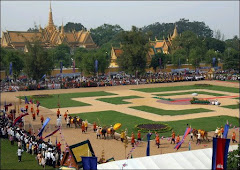

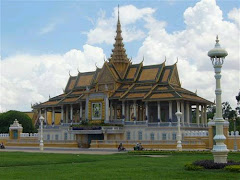

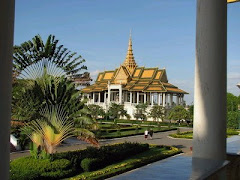
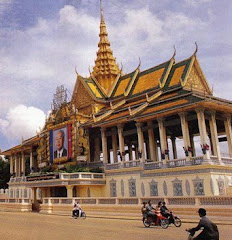
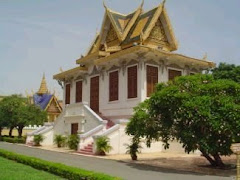
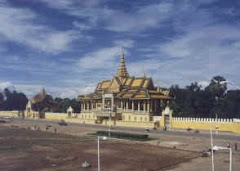
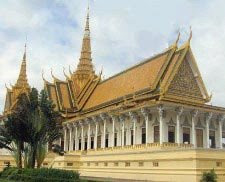

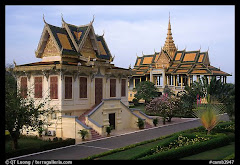





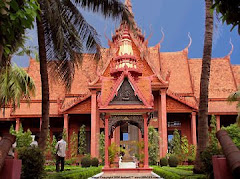
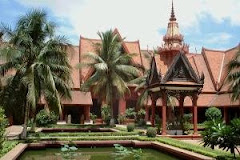




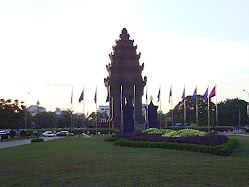



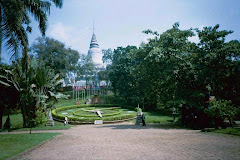

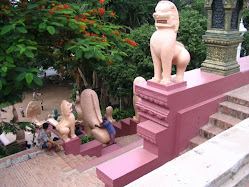
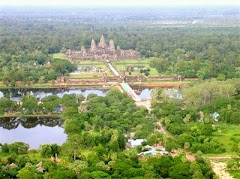
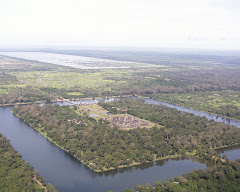

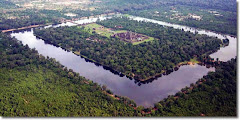
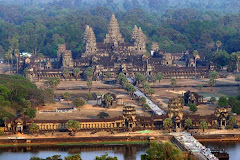
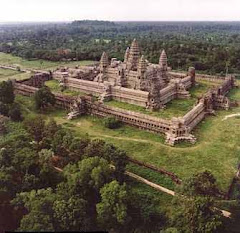
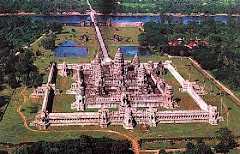
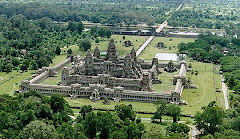
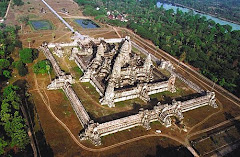

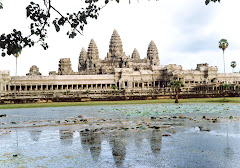

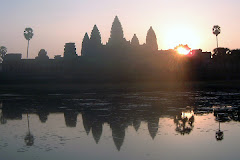
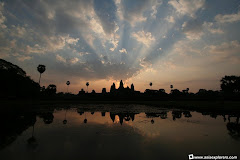
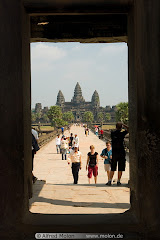
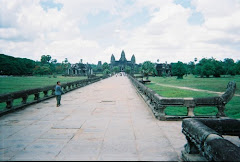
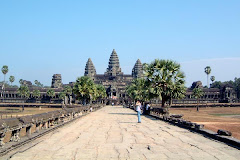
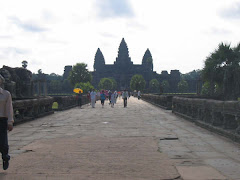
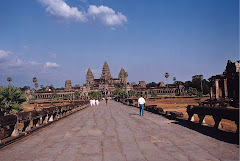
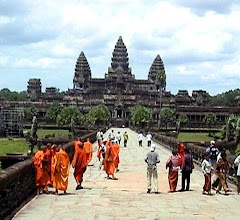
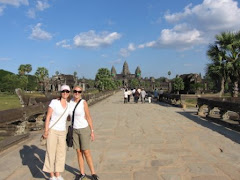
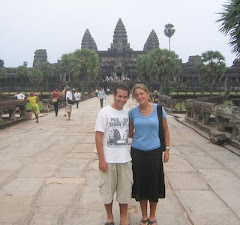
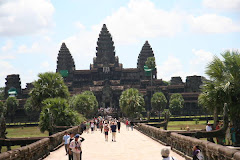
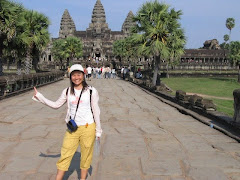
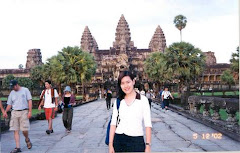

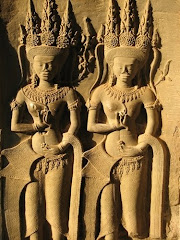

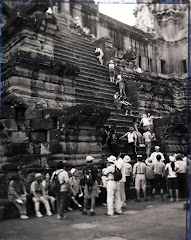

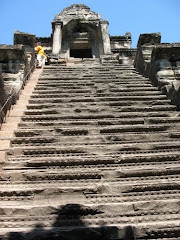

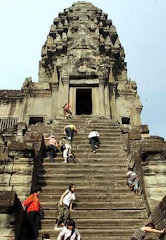
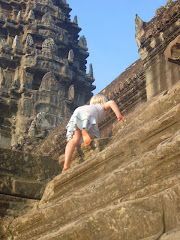
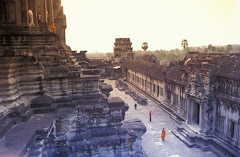
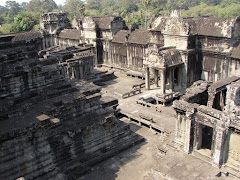
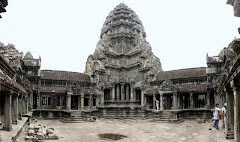
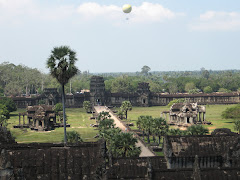


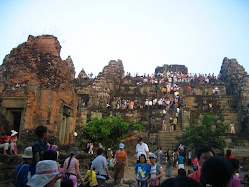

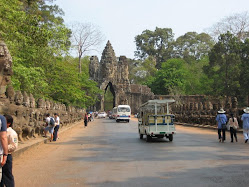

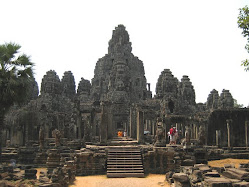
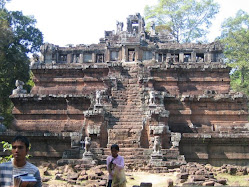.jpg)

